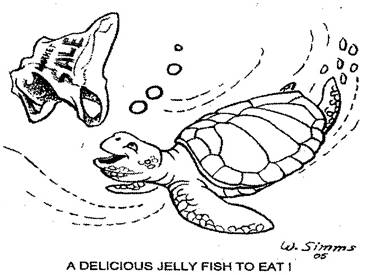Appeared in Vall-E-Vents, the San Fernando Valley Sierra Club Newsletter, Sept., 2005.
Plastics in the Food Chain
(#3 of the Plastic Plague Series)
by Sarah S. Mosko, Ph.D.

Japanese researchers suggest that plastic debris is a transporter of toxic chemicals into the marine food chain. Illustration by Willis Simms.
Plastics are petroleum products that never biodegrade…they just break up into smaller and smaller fragments of plastic.
Worldwide plastics production has grown to over 150 million tons/year, and lots of it finds its way into our oceans. Captain Charles Moore of the Algalita Marine Research Foundation in Long Beach, Calif. has trawled the surface waters of the N. Pacific central gyre, a Texas-sized whirlpool of ocean debris sometimes referred to as the Pacific Garbage Patch. He compared the weight of plastic fragments to that of zooplanktons. Zooplanktons are tiny animal planktons at the bottom of the aquatic food chain and a prime food source for a myriad of sea creatures.
Quite alarmingly, Captain Moore found that plastics outweighed zooplanktons by a factor of 6-to-1.1 Even off the Southern California coastline, plastics were found to outweigh zooplanktons 2.5 to 1.2 Since fish, turtles, jellies, seabirds and other sea creatures are not equipped to distinguish  plastics from real food, plastics have become a routine part of the marine food chain. Microscopic bits of plastic are even being incorporated into plankton,3 showing that plastics have entered the very bottom of our food chain.
plastics from real food, plastics have become a routine part of the marine food chain. Microscopic bits of plastic are even being incorporated into plankton,3 showing that plastics have entered the very bottom of our food chain.
Adding to the alarm are the findings of Japanese researchers suggesting that plastic debris is a transporter of toxic chemicals into the marine food chain. Because plastics are petroleum-based, they are oily and so attract oily toxins like PCBs and DDE (PCBs are a family of toxic, persistent chemicals previously used in electrical equipment, and DDE is a breakdown product of the now banned pesticide DDT). The study focused on plastic resin pellets, the pearl-sized materials that are melted down to form plastic products. The pellets were found to accumulate PCBs and DDE at levels up to one million times their concentrations in the surrounding seawater.
Oily toxins are stored generally in fatty tissues and consequently get concentrated as they are passed up the food chain (plankton are eaten by jellyfish, salmon eat the jellyfish, you serve salmon for dinner). The potential threat to humans eating at the top of the food chain is obvious. We don’t know yet how big a role plastic ocean debris plays in the elevated levels of PCBs, DDE and other toxins now commonly measured in human tissues. The studies needed to assess this simply have not been done. However, two things are abundantly clear – our oceans are turning into cesspools of plastic trash because of human negligence, and we will eventually eat everything we throw into the sea. We don’t need new studies to tell us this!
1Moore et al.Marine Poll. Bull., 42, 2001.
2Moore et al. Marine Poll. Bull., 44, 2002.
3Thompson et al. Science 304, 2004.
4Mato et al. Environ. Sci. Bull. 35, 2001.



 Posted by Sarah (Steve) Mosko
Posted by Sarah (Steve) Mosko 